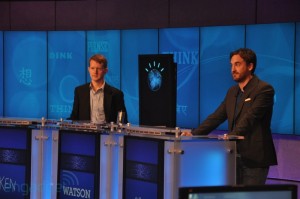We all knew it would come to this. From the time back in 1968 when “2001: A Space Odessy”  scared us senseless, we knew computers would one day rule the world . . . and the universe. Then it was Hal, the prophetic image of the all knowing computer possessed of the human capacity to dominate and destroy others.
scared us senseless, we knew computers would one day rule the world . . . and the universe. Then it was Hal, the prophetic image of the all knowing computer possessed of the human capacity to dominate and destroy others.
When Watson trounced former Jeopardy champions, Ken Jennings and Brad Rutter earlier this week, the machine beat the men. Watson finished with game winnings of $77,147, Jennings with $24,000 and Rutter with $21,600. In addition, Watson’s victory sent $1,000,000 to its (his) favorite charity. It seemed that we witnessed the Hal prophecy come true this week.
Or did we?
Some think so. The Wall Street Journal reported this week that “servers” such as doctors and lawyers hold jobs which are truly in jeopardy. According to hedge fund manager and author, Andy Kessler, technology will gradually replace those who answer questions from consumers under a grant of licensed exclusivity. See, Is Your Job an Endangered Species? Citing the degree to which ediscovery technology replaces the work previously done by lawyers and paralegals, Kessler observes that much of what lawyers currently do eventually will be done by computers (like Watson).
However, even Kessler’s pessimistic (or realistic) view of the impact of technology on the serving professions recognizes a significant difference between servers and creators. Until artificial intelligence can do more than merely search for answers (like Google and Watson), humans have the edge in the realm of creativity.
I was reminded of this also this week when I attended the Napier-Looby Bar Foundation banquet in Nashville which recognized the powerful work of lawyers in changing the world for the better. In addition to awards given to local members of the African-American bar for their work in social change, we heard from the “King of the Court”. Perry Wallace was the first black basketball player to play in the Southeastern Conference. He was recruited by Vanderbilt University in 1966 and was treated to unimaginable hostility in university arenas across the South as he broke through the previously all-white world of SEC basketball.
Wallace later went to law school at Columbia and has impacted the world through his work as a lawyer and educator. He currently serves as a professor of law at Washington College of Law. He has been a trial attorney for the U.S. Department of Justice. He told the story of his involvement in cases like that of a woman condemned to death by stoning for adultery in a Middle Eastern country while her adulterous partner was spared any penalty whatever.
Watson and his descendants will never accomplish feats of courage, conscience and creativity like that. There always will be a place for those who can change the course of history, not simply recount it.
However, lawyers who are content to perform tasks best performed by computers are an endangered species and will find their jobs outsourced and techno-sourced leaving the creative lawyers in greater demand than ever before.
Heeding the warnings of Kessler and Watson will serve the legal profession and the clients it serves extremely well. For example, turning the project management of activities and resources over to the process efficiency of computer systems will allow the creative lawyers greater freedom to build their professional resume, provide innovative solutions to client problems, improve their business portfolio and add value to their firms and their clients.
They will also begin to enjoy their world of professional achievement much more than merely working harder at doing what computers do best.
Take that, Watson!



 Posted by lcmlarry
Posted by lcmlarry 






